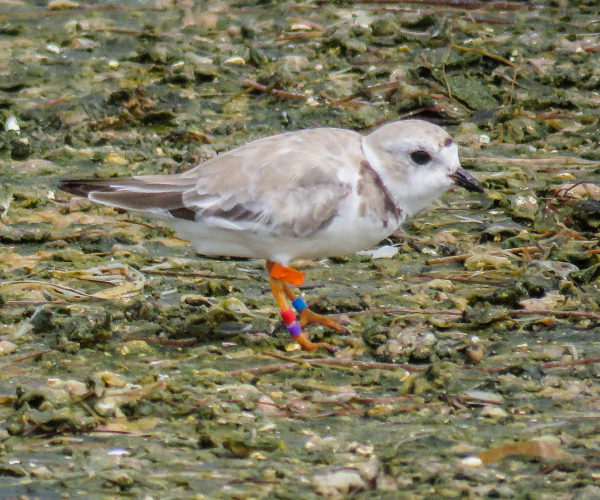
The color-banded female Piping Plover that nests at Montrose Beach in Chicago and winters on Anclote Key in coastal Florida (photo by Ally Kristan).
|
Recent successes for the Great Lakes population of Piping Plovers were emphasized when a color-banded female that nested on a popular Chicago beach was sighted after completing her migration to a Gulf Coast barrier island in Florida. This Piping Plover has been studied since 2017, and was observed last week at Anclote Key Preserve State Park, offshore from Tarpon Springs. Piping Plovers have only recently increased in the Great Lakes region: At one time fewer than 20 pairs were present, but today Great Lakes beaches host almost 70 nesting pairs thanks to recovery efforts. Historically, up to 800 pairs nested along the Great Lakes.
The female Piping Plover noted above made headlines back in 2019 when she and her mate selected Montrose Beach in Chicago as their nest site, the first nesting attempt by Piping Plovers in the Chicago area since the 1950s! Since their first nesting attempt, this color-banded pair has successfully raised 7 fledglings, including 2 this summer. They join 121 other fledglings raised by successful nesting pairs along the shores of the Great Lakes this season, the highest number of Piping Plover fledglings since 2018.
By mid-August, the plovers begin to migrate south, and that’s where the work of Chicago’s team of plover banders really takes on significance. Understanding where Piping Plovers spend the winter is just as important as knowing where they nest, and the destinations of some populations of Piping Plovers were unknown until recently. Unlike the Chicago female, the male of that pair was spotted along the Texas coast in mid-August. But by the end of August the female hadn’t been sighted since leaving Chicago; as August drew to a close, biologists, beach stewards, and birders alike were on the lookout for the color-banded female.
“Migration is one of the most challenging periods in a bird's life,” explained Stephanie Beilke, conservation science manager at Audubon Great Lakes and one of a team of biologists who monitor the Montrose Beach plovers each summer. “The over-wintering period isn’t necessarily any easier, because birds may be threatened by hurricane season, as well as vehicles and dogs on beaches.”
It had been a few weeks since the Audubon Great Lakes team heard about the female’s whereabouts, until Ally Kristan, the Three Rooker Island stewardship coordinator for Audubon Florida, managed to see her. She was 1 of 3 banded Piping Plovers in a huge mixed flock of shorebirds, recalled Kristan. “She refused to face directly at me and kept watching me out of the corner of her eye as she weaved in and out of hiding spots behind vegetation.”
After taking a few photos of the plover that showed its bands, Kristan contacted Alice Van Zoeren, who is part of the Great Lakes Piping Plover Conservation Team. Van Zoeren confirmed that the Piping Plover was the Chicago female. Kristan found 14 Piping Plovers altogether, including the Chicago female that has spent every winter at Anclote Key since she fledged in 2017.
“It is astonishing that these tiny birds are able to fly all the way down to our neck of the woods and successfully find these small barrier islands in the Anclote Key Preserve State Park year after year,” said Kristan. “Finding a banded bird during a survey feels like Christmas morning every time!”
To reference the original Audubon article, see https://www.audubon.org/news/chicagos-rose-piping-plover-hits-beach-florida-just-time-world-shorebird-day